 This is the second of three blogs looking at high inflation and its implications. Here we look at changes in the housing market and its effects on households. Another way of analysing the financial importance of the housing and mortgage markets is through the balance sheets and associated flow accounts of the household sector.
This is the second of three blogs looking at high inflation and its implications. Here we look at changes in the housing market and its effects on households. Another way of analysing the financial importance of the housing and mortgage markets is through the balance sheets and associated flow accounts of the household sector.
We used the concept of balance sheets in our blog Bank failures and the importance of balance sheets. In the blog we referred to the balance-sheet effects from interest rate hikes on the financial well-being of financial institutions.
The analysis is analogous for households. Again, we can identify two general effects: rising borrowing and debt-servicing costs, and easing asset prices.
The following table shows the summary balance sheet of the UK household sector in 1995 and 2021.

Source: National balance sheet estimates for the UK: 1995 to 2021 (January 2023) and series RPHA, ONS
The total value of the sector’s net wealth (or ‘worth’) is the sum of its net financial wealth and its non-financial assets. The former is affected by the value of the stock of outstanding mortgages, which we can see from row 3 in the table (‘loans secured on dwellings’) has increased from £390 billion in 1995 to £1.56 trillion in 2021. This is equivalent to an increase from 70 to 107 per cent of the sector’s annual disposable income. This increase helps to understand the sensitivity of the sector’s financial position to interest rate increases and the sizeable cash flow effects. These effects then have implications for the sector’s spending.
 Housing is also an important asset on household balance sheets. The price of housing reflects both the value of dwellings and the land on which they sit, and these are recorded separately on the balance sheets. Their combined balance sheet value increased from £1.09 trillion (£467.69bn + £621.49bn) in 1995 to £6.38 trillion (£1529.87bn + £4853.16bn) in 2021 or from 128% of GDP to 281%.
Housing is also an important asset on household balance sheets. The price of housing reflects both the value of dwellings and the land on which they sit, and these are recorded separately on the balance sheets. Their combined balance sheet value increased from £1.09 trillion (£467.69bn + £621.49bn) in 1995 to £6.38 trillion (£1529.87bn + £4853.16bn) in 2021 or from 128% of GDP to 281%.
The era of low inflation and low interest rates that had characterised the previous two decades or so had helped to boost house price growth and thus the value of non-financial assets on the balance sheets. In turn, this had helped to boost net worth, which increased from £2.78 trillion in 1995 to £12.29 trillion in 2021 or from 319% of GDP to 541%.
Higher interest rates and wealth
 The advent of higher interest rates was expected not only to impact on the debt servicing costs of households but the value of assets, including, in the context of this blog, housing. As Chart 3 in the previous blog helped to show, higher interest rates and higher mortgage repayments contributed to an easing of house price growth as housing demand eased. On the other hand, the impact on mortgaged landlords helped fuel the growth of rental prices as they passed on their increased mortgage repayment costs to tenants.
The advent of higher interest rates was expected not only to impact on the debt servicing costs of households but the value of assets, including, in the context of this blog, housing. As Chart 3 in the previous blog helped to show, higher interest rates and higher mortgage repayments contributed to an easing of house price growth as housing demand eased. On the other hand, the impact on mortgaged landlords helped fuel the growth of rental prices as they passed on their increased mortgage repayment costs to tenants.
Higher interest rates not only affect the value of housing but financial assets such as corporate and government bonds whose prices are inversely related to interest rates. Research published by the Resolution Foundation in July 2023 estimates that these effects are likely to have contributed to a fall in the household wealth from early 2021 to early 2023 by as much as £2.1 trillion.
The important point here is that further downward pressure on asset prices is expected as they adjust to higher interest rates. This and the impact of higher debt servicing costs will therefore continue to impact adversely on general financial well-being with negative implications for the wider macroeconomic environment.
Articles
- The Mortgage Crunch
Resolution Foundation, Simon Pittaway (17/6/23)
- Peaked Interest?
Resolution Foundation, Molly Broome, Ian Mulheirn and Simon Pittaway (17/7/23)
- UK inflation to fall to lowest level since March 2022 but Bank of England still tipped to hike interest rates
City A.M., Jack Barnett (17/7/23)
- Mortgage payments set to jump by £500 for one million households
BBC News, Tom Espiner (13/7/23)
- Interest rates: Big rise less likely after inflation surprise
BBC News, Daniel Thomas, Faisal Islam & Dharshini David (19/7/23)
- Rising Mortgage Costs. What Can Be Done?
NIESR blog, Max Mosley and Adrian Pabst (17/7/23)
- UK interest rates forecast to rise less sharply after inflation falls to 7.9%
The Guardian, Richard Partington (19/7/23)
- Mortgage costs: More Scots falling behind on repayments
Herald Scotland, Kristy Dorsey (18/7/23)
Report
Data
Questions
- What possible indicators could be used to assess the affordability of residential house prices?
- What do you understand by the concept of the monetary policy transmission mechanism? How do the housing and mortgage markets relate to this concept?
- What factors might affect the proportion of people taking out fixed-rate mortgages rather than variable-rate mortgages?
- What is captured by the concept of net worth? Discuss how the housing and mortgage markets affect the household sector’s net worth.
- What are cash-flow effects? How do rising interest rates effect savers and borrowers?
- How might wealth effects from rising interest rates impact younger and older people differently?
- Discuss the ways by which house price changes could affect household consumption.
 This is the first of three blogs looking at inflation, at its effect on household budgets and at monetary policy to bring inflation back to the target rate. This first one takes an overview.
This is the first of three blogs looking at inflation, at its effect on household budgets and at monetary policy to bring inflation back to the target rate. This first one takes an overview.
The housing and mortgage markets are vitally important to the financial well-being of many households. We have seen this vividly in recent times through the impact of rising inflation rates on interest rates and, in turn, on mortgage repayments. Some people on variable rate mortgages, or whose fixed rate deals are coming to the end of their term, have struggled to pay the new higher rates. In this blog we explore the reasons behind these events and the extent to which the financial well-being of UK households has been affected.
Chart 1 shows the path of inflation in the UK since 1997 when the Bank of England’s Monetary Policy Committee (MPC) was first charged with meeting an inflation rate target (click here for a PowerPoint). It captures the impact of the inflation shock that began to emerge in 2021 and saw the CPI inflation rate peak at 11.1 per cent in October 2022 – considerably above the Bank’s 2 per cent target.
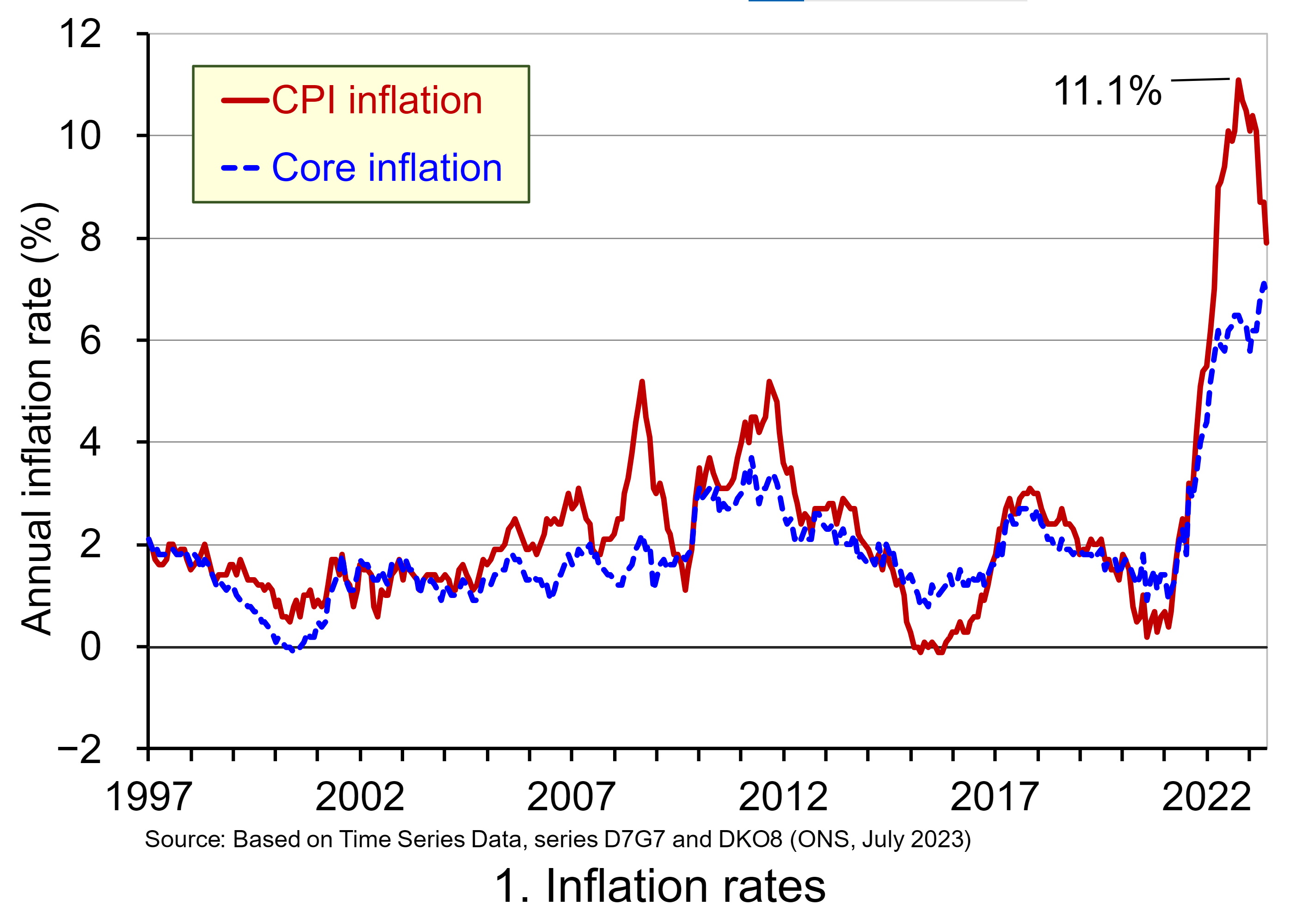 Despite easing somewhat, the CPI inflation rate is showing signs of persistence – meaning that it is taking time for it to return to target. One way of understanding this persistence is to look at a measure of inflation known as core inflation. This inflation rate measure excludes energy, food, alcoholic beverages and tobacco prices, all of which are notoriously volatile. Core inflation thus captures underlying inflationary pressures.
Despite easing somewhat, the CPI inflation rate is showing signs of persistence – meaning that it is taking time for it to return to target. One way of understanding this persistence is to look at a measure of inflation known as core inflation. This inflation rate measure excludes energy, food, alcoholic beverages and tobacco prices, all of which are notoriously volatile. Core inflation thus captures underlying inflationary pressures.
To address the inflationary pressures, the Bank of England began raising Bank Rate in December 2021 from a low of just 0.1 per cent. By June 2023 the Bank Rate had risen to 5 per cent with the prospect of further hikes. As the Bank Rate rises, the cost of borrowing from the Bank of England by commercial banks rises too. Therefore increases in the Bank Rate ripple through to other interest rates. However, the passthrough effect can be uneven affecting spreads between Bank Rate and other interest rates.
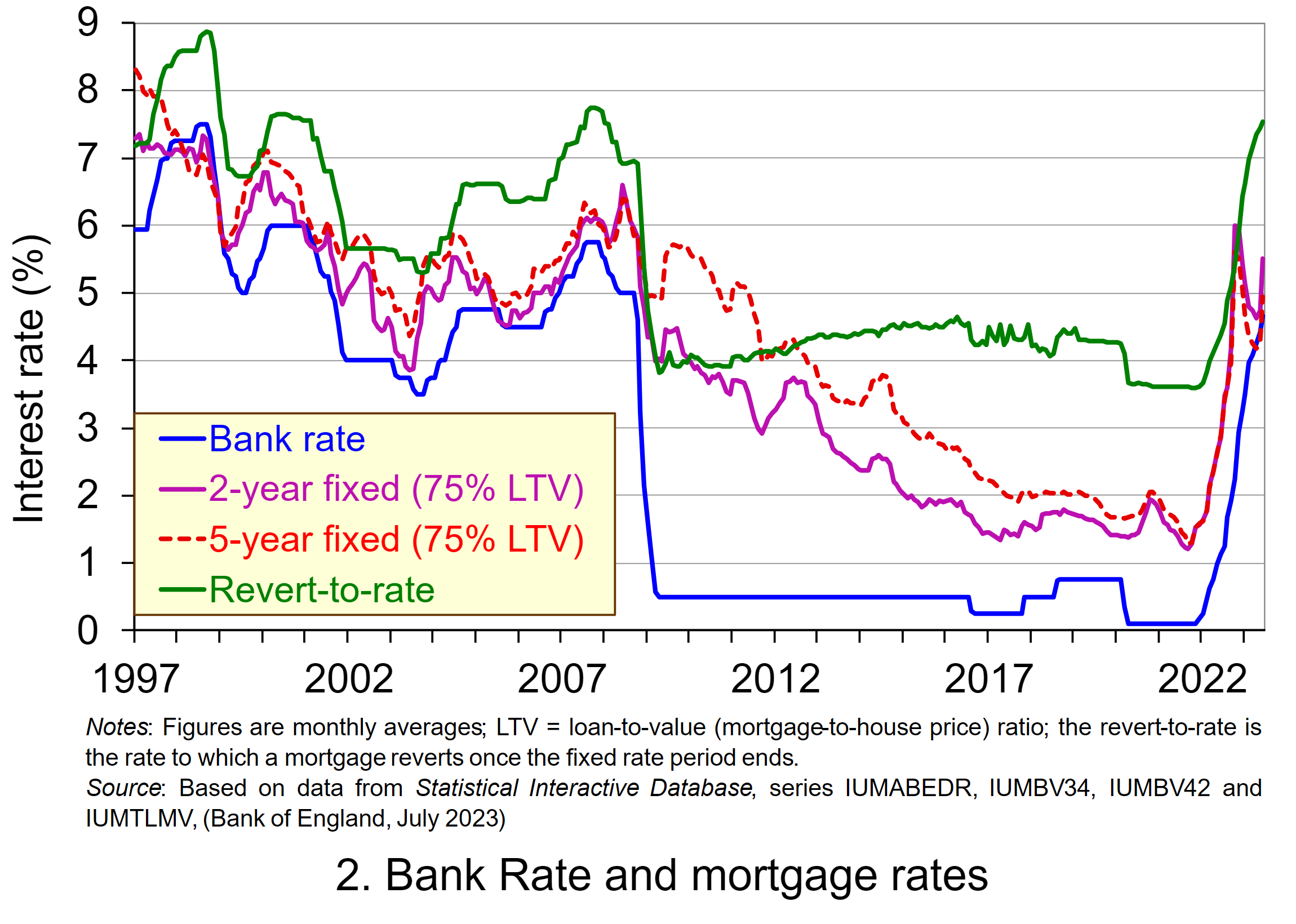 The increase in the Bank Rate is reflected in the increases in mortgage rates shown in Chart 2 (click here for a PowerPoint). As we have seen, this affects most immediately those with variable rate mortgages, and then those with fixed-rate mortgages as they come up for renewal. Analysis from the Resolution Foundation (2023) estimates that 4.2 million households saw their mortgage rates change between December 2021 and June 2023 – the equivalent of 56 per cent of mortgaged households.
The increase in the Bank Rate is reflected in the increases in mortgage rates shown in Chart 2 (click here for a PowerPoint). As we have seen, this affects most immediately those with variable rate mortgages, and then those with fixed-rate mortgages as they come up for renewal. Analysis from the Resolution Foundation (2023) estimates that 4.2 million households saw their mortgage rates change between December 2021 and June 2023 – the equivalent of 56 per cent of mortgaged households.
The persistence of inflation means that mortgage rates may not have yet peaked and are likely to stay higher for longer than originally thought. With fixes normally between two to five years, the problem of higher rates for those renewing will continue. The Resolution Foundation projects that by the end of 2026, almost all households with a mortgage would have moved to a higher rate since December 2021. At this point, the typical annual repayment cost for mortgaged households is forecast to be £2000 per annum higher, leading to an increase in annual repayments for the UK household sector of £15.8 billion.
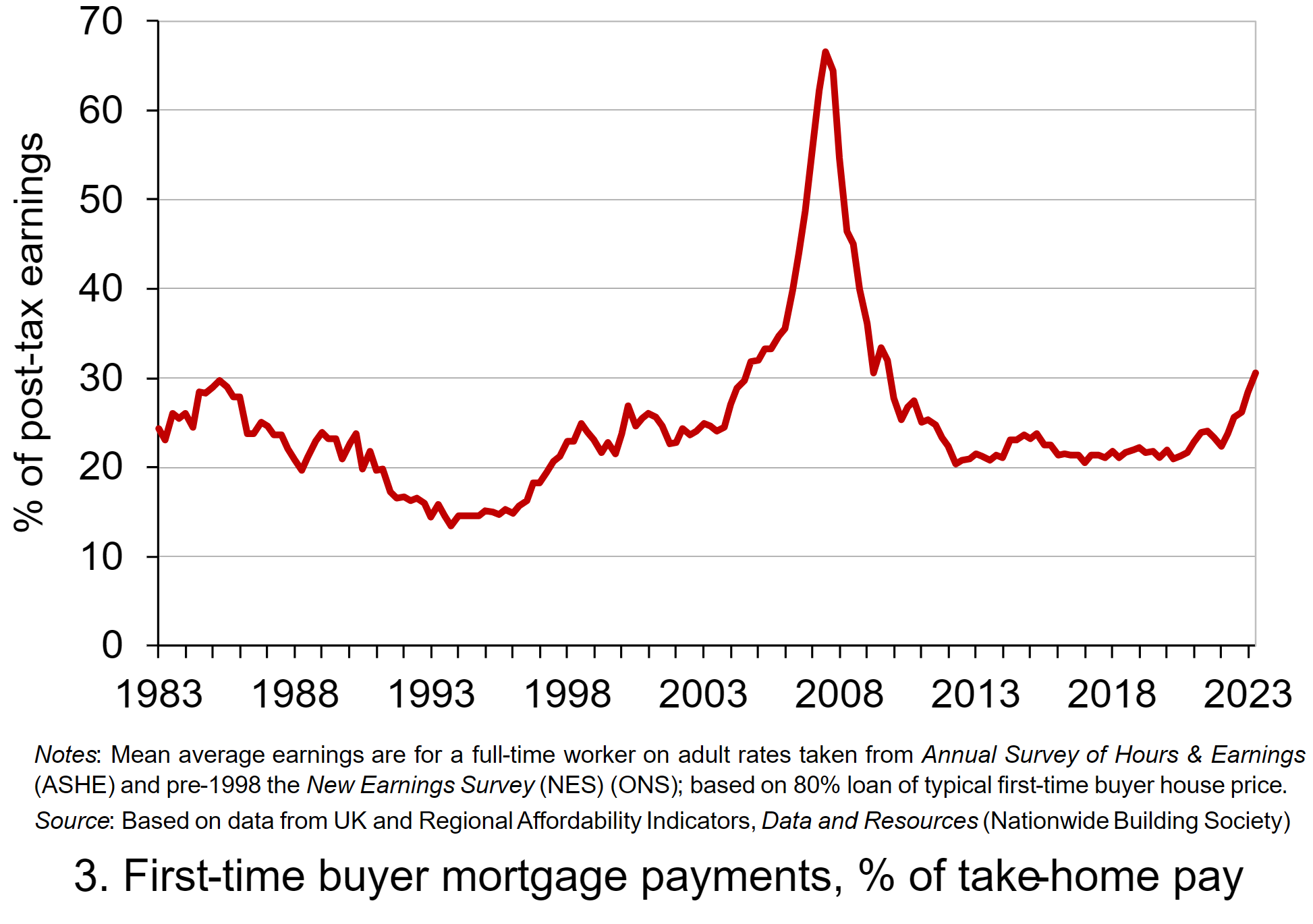 Chart 3 provides a visual picture of the typical annual repayment costs facing first-time buyers as a percentage of earnings after tax and national insurance (click here for a PowerPoint). The Nationwide Building Society figures are based on an 80% loan on the typical first-time buyer house price. It shows that repayment costs have been rising sharply on the back of rising interest rates and are now higher than at any time since the global financial crisis of 2007–8.
Chart 3 provides a visual picture of the typical annual repayment costs facing first-time buyers as a percentage of earnings after tax and national insurance (click here for a PowerPoint). The Nationwide Building Society figures are based on an 80% loan on the typical first-time buyer house price. It shows that repayment costs have been rising sharply on the back of rising interest rates and are now higher than at any time since the global financial crisis of 2007–8.
Articles
- UK inflation to fall to lowest level since March 2022 but Bank of England still tipped to hike interest rates
City A.M., Jack Barnett (17/7/23)
- UK inflation and interest rates high – how do other economies compare?
BBC News, Dharshini David (23/7/23)
- Mortgage payments set to jump by £500 for one million households
BBC News, Tom Espiner (13/7/23)
- Interest rates: Big rise less likely after inflation surprise
BBC News, Daniel Thomas, Faisal Islam & Dharshini David (19/7/23)
- Rising Mortgage Costs. What Can Be Done?
NIESR blog, Max Mosley and Adrian Pabst (17/7/23)
- UK interest rates forecast to rise less sharply after inflation falls to 7.9%
The Guardian, Richard Partington (19/7/23)
- Mortgage costs: More Scots falling behind on repayments
Herald Scotland, Kristy Dorsey (18/7/23)
- The Mortgage Crunch
Resolution Foundation, Simon Pittaway (17/6/23)
- Peaked Interest?
Resolution Foundation, Molly Broome, Ian Mulheirn and Simon Pittaway (17/7/23)
Data
Questions
- What possible indicators could be used to assess the affordability of residential house prices?
- What is captured by the rate of core inflation? Discuss the arguments for using this as the target inflation rate measure.
- What factors might affect the proportion of people taking out fixed-rate mortgages rather than variable-rate mortgages?
- Discuss the ways by which house price changes could impact on household consumption.
- Investigate the proportion of mortgages that are fixed rate and the typical length of the fixed rate term in two European countries, the USA and Japan. How does each differ from the UK?
Effects on competition in the console and cloud gaming markets
 Many people in the games industry expected the Competition and Markets Authority (CMA) to approve Microsoft’s proposed takeover of the games business, Activision Blizzard. However, in its final report published on 26 April, the CMA stated that the takeover would result in a substantial lessening of competition (SLC) in the supply of cloud gaming services in the UK. It rejected a behavioural remedy proposed by Microsoft and concluded that the merger should be prohibited.
Many people in the games industry expected the Competition and Markets Authority (CMA) to approve Microsoft’s proposed takeover of the games business, Activision Blizzard. However, in its final report published on 26 April, the CMA stated that the takeover would result in a substantial lessening of competition (SLC) in the supply of cloud gaming services in the UK. It rejected a behavioural remedy proposed by Microsoft and concluded that the merger should be prohibited.
When analysing the potential impact of this merger, the CMA focused on the following three issues:
- How important is the availability of Activision Blizzard’s games for the competitiveness of Microsoft’s rivals in the console and cloud gaming market? If, following the merger, Microsoft used its control over Activision Blizzard to restrict the availability of the games, would this significantly harm the competitiveness of their rivals?
- If restricting the availability of the games did harm its rivals, would it be profitable for Microsoft to do so? Do the benefits outweigh the costs? The major benefit for Microsoft is the additional sales this generates as consumers switch to its products to gain access to Activision’s games. The major cost is the forgone sales of the games to their rivals in the console and cloud gaming market.
- If it is profitable for Microsoft to limit the availability of the games, would this policy lead to a substantial lessening of competition (SLC) in the console and cloud gaming market? To answer this question the CMA compared the level of competition that would be most likely to occur if the merger were to proceed with the level if the deal were prohibited? In other words, it needed to identify the counterfactual.
 In response to the first issue, the CMA judged that restricting access to Activision Blizzard’s games post-merger would significantly harm the competitiveness of Microsoft’s rivals in both the console and cloud gaming markets. However, its judgment on the second issue differed between the two markets. Why was this? One key issue was the difference in the relative market power of Microsoft in cloud vs console gaming.
In response to the first issue, the CMA judged that restricting access to Activision Blizzard’s games post-merger would significantly harm the competitiveness of Microsoft’s rivals in both the console and cloud gaming markets. However, its judgment on the second issue differed between the two markets. Why was this? One key issue was the difference in the relative market power of Microsoft in cloud vs console gaming.
One common indicator used to analyse the market position of a business relative to its rivals is market share. Using data on revenues generated from the sales of hardware, associated games and subscription services, console gaming market shares in the UK for 2021 were as follows:
- Sony (PlayStation): 40% – 50%
- Microsoft (xBox): 30% – 40%
- Nintendo (Switch): 10% – 20%
Given the important market position of the PlayStation, limiting the ability of its users to purchase Activision games would result in Microsoft forgoing significant sales and revenue. Detailed analysis of the data by the CMA, indicated that the costs outweighed the benefits and so Microsoft did not have a commercial incentive to limit the availability of the games in this market. Therefore, the CMA concluded that the merger would not result in a SLC in the console gaming market. This finding was discussed in more detail in a blog on this website in March 2023.
The CMA judged that Microsoft had a much stronger position in the market for cloud gaming.
Cloud gaming services
 Cloud gaming offers consumers a new way of playing graphically complex games. In this sector of the market, the games run on remote servers/data centres and then stream over the internet to the user’s device. The great advantage with this approach is that it enables consumers to play games on less powerful hardware devices such as smartphones, tablets, smart televisions, and standard PCs. Although the market is currently quite small it, has grown significantly over the past couple of years. Some people argue that it has the potential to make a dramatic change to the gaming market in the same way that businesses such as Netflix and Spotify have transformed the film, TV, and music industries.
Cloud gaming offers consumers a new way of playing graphically complex games. In this sector of the market, the games run on remote servers/data centres and then stream over the internet to the user’s device. The great advantage with this approach is that it enables consumers to play games on less powerful hardware devices such as smartphones, tablets, smart televisions, and standard PCs. Although the market is currently quite small it, has grown significantly over the past couple of years. Some people argue that it has the potential to make a dramatic change to the gaming market in the same way that businesses such as Netflix and Spotify have transformed the film, TV, and music industries.
It is more difficult to judge the relative market position of firms in a new and dynamic market, where things can change very quickly. The use of market share data is less informative but can still offer some insights. To estimate market shares in cloud gaming, the CMA used data on the number of monthly active users (MAUs). The figures for paid services in the UK for 2022 were as follows:
- xCloud (Microsoft): 70% – 80%
- PlayStation Cloud Gaming (Sony): 20% – 30%
- Boosteroid: 0 – 5%
- Nvidia GFN: 0 – 5%
Data suggest that Microsoft has a much stronger position in this market than in console gaming. There is also evidence that its market position is becoming more dominant. The same market shares for xCloud and PlayStation Gaming in 2021 were 40% – 50% and 50% – 60% respectively.
Given some of the limitations of using market-share data in a new and dynamic market, the CMA analysed other information about the sector to assess Microsoft’s market position. The investigation identified three key factors that could give Microsoft a significant cost advantage over its rivals: cloud infrastructure, the Windows operating system and access to a wide variety of games.
- Infrastructure: Microsoft’s ownership of Azure, a major cloud computing platform, could give it a significant cost advantage over its rivals in the future. A rival firm would need to develop it own cloud infrastructure or purchase these services from a third-party supplier.
- The Windows operating system: Given that far more games are developed for Windows as opposed to other operating systems, using Windows on a cloud infrastructure system gives a supplier access to large number of games. As it already owns Windows, Microsoft will be able to supply the operating system to its own cloud gaming service at little additional cost whereas its rivals will have to pay a license fee.
- Access to a wide range of games: Microsoft already owns twenty-four development studios that produce some very successful games such as Minecraft and Halo. It also has commercial relationships with other third-party developers who produce games for the Xbox console. This gives Microsoft another advantage over many of its rivals.
Given this evidence on Microsoft’s strong market position, the CMA concluded that the benefits to the company of restricting the availability of the games in the cloud gaming market outweighed the costs.
If Microsoft has commercial incentives to restrict the availability of Activision’s games, would this strategy lead to a SLC in the market for cloud gaming? To answer this question, the CMA had to identify the counterfactual: i.e. the most likely outcome in the market if the merger did not proceed. Following detailed analysis of the evidence, the competition authority concluded that Activision was likely to make its games available to different cloud gaming services if the deal did not take place.
Given Microsoft’s (a) strong market position and (b) limited number of relatively small competitors in cloud gaming, the CMA concluded that Microsoft’s commercial incentive to restrict the availability games would lead to a SLC compared to the counterfactual.
Martin Coleman, the chair of the independent panel of experts who conducted the CMA’s investigation, stated that:
Microsoft already enjoys a powerful position and head start over other competitors in cloud gaming and this deal would strengthen that advantage giving it the ability to undermine new and innovative competitors.
In response to these competition concerns, Microsoft offered to supply Activision games to certain cloud gaming services for a 10-year period. However, the CMA concluded that this behavioural remedy was not enough to address the competition issues raised by the merger and recommended that the deal be prohibited.
Microsoft’s immediate response was to appeal the decision to the Competition Appeal Tribunal.
The Federal Trade Commission is currently investigating the impact of the deal in the USA while the European Commission has just completed its investigation in the European Union. On 15 May, the EC announced that Microsoft’s behavioural remedy did fully address the competition concerns identified during its investigation. Therefore, the merger was approved on condition that Microsoft fully implemented the actions outlined in the remedy.
It will be interesting to read the recommendations of the FTC when the final results of its investigation are published later this year.
Articles
CMA and EC press releases
Questions
- Discuss the barriers to entry that exist in both the console and cloud gaming markets.
- Outline some of the issues when trying to calculate market shares in cloud gaming.
- What is meaning of the term ‘input foreclosure’? How is this relevant to the Microsoft/Activision case?
- What is the difference between a behavioural and a structural remedy? In what circumstances is a behavioural remedy most likely to be effective?
- Discuss some of the potential limitations with the behavioural remedy proposed by Microsoft.
- Explain why Microsoft’s position in the downstream market for cloud gaming is likely to influence incentives it faces to restrict the availability of Activision’s games post-merger.
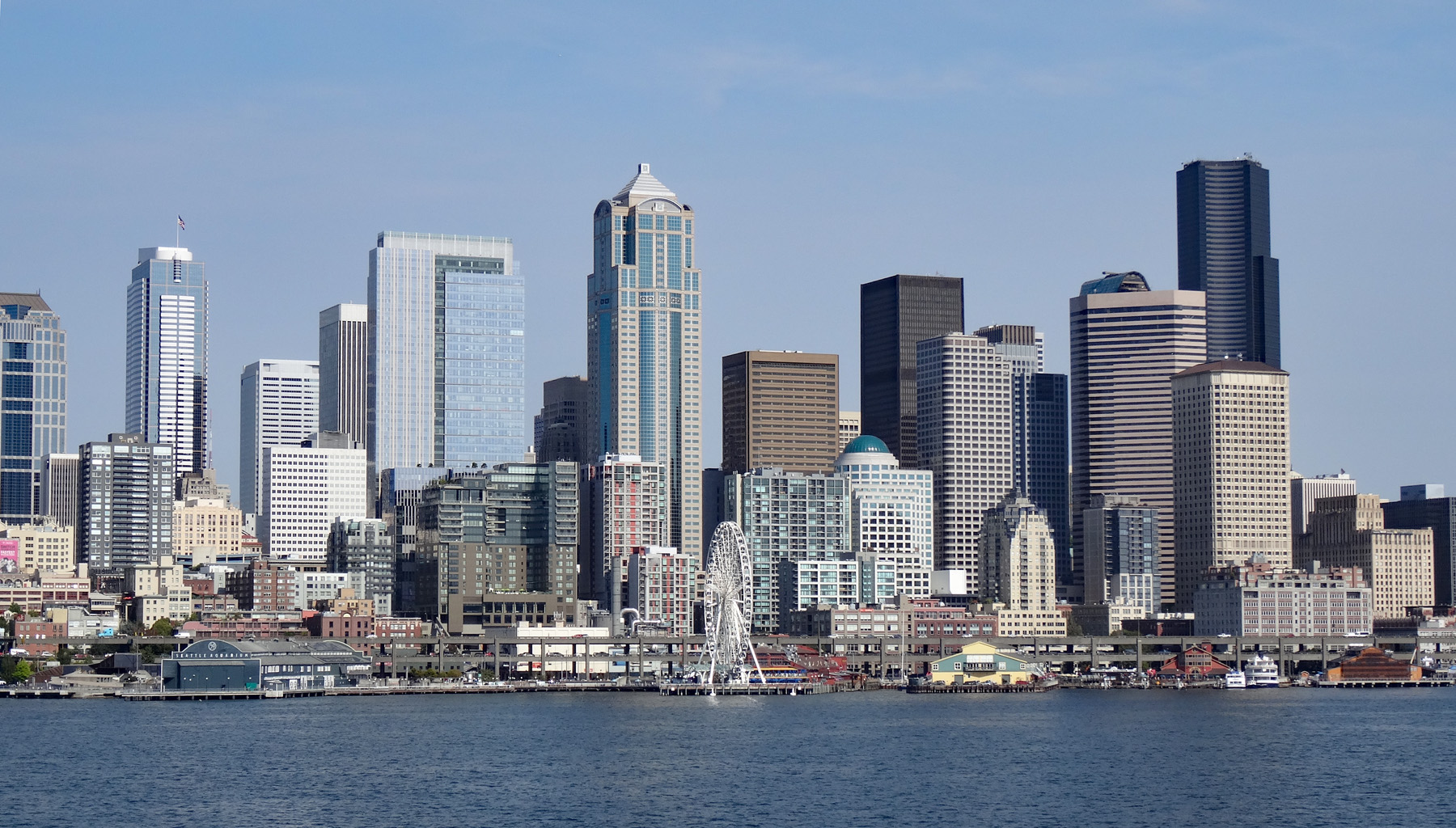 March 2023 saw the failure of Silicon Valley Bank (SVB), a regional US bank based in California that focused on financial services for the technology sector. It also saw the forced purchase of global-banking giant, Credit Suisse, by rival Swiss bank, UBS. These events fuelled concerns over the banking sector’s financial well-being, with fears for other financial institutions and the wider economy.
March 2023 saw the failure of Silicon Valley Bank (SVB), a regional US bank based in California that focused on financial services for the technology sector. It also saw the forced purchase of global-banking giant, Credit Suisse, by rival Swiss bank, UBS. These events fuelled concerns over the banking sector’s financial well-being, with fears for other financial institutions and the wider economy.
Yet it is not the only sector where concerns abound over financial well-being. The cost-of-living crisis, the hike in interest rates and the economic slowdown continue to have an adverse impact on the finances of households and businesses. Furthermore, many governments face difficult fiscal choices in light of the effects of recent economic shocks, such as COVID and the Russian invasion of Ukraine, on the public finances.
Balance sheets and flow accounts
When thinking about the financial well-being of people, business and governments it is now commonplace for economists to reference balance sheets. This may seem strange to some since it is easy to think of balance sheets as the domain of accountants or those working in finance. Yet balance sheets, and the various accounts that lie behind them, are essential in analysing financial well-being and, therefore, in helping to understand economic behaviour and outcomes. Hence, it is important for economists to embrace them too.
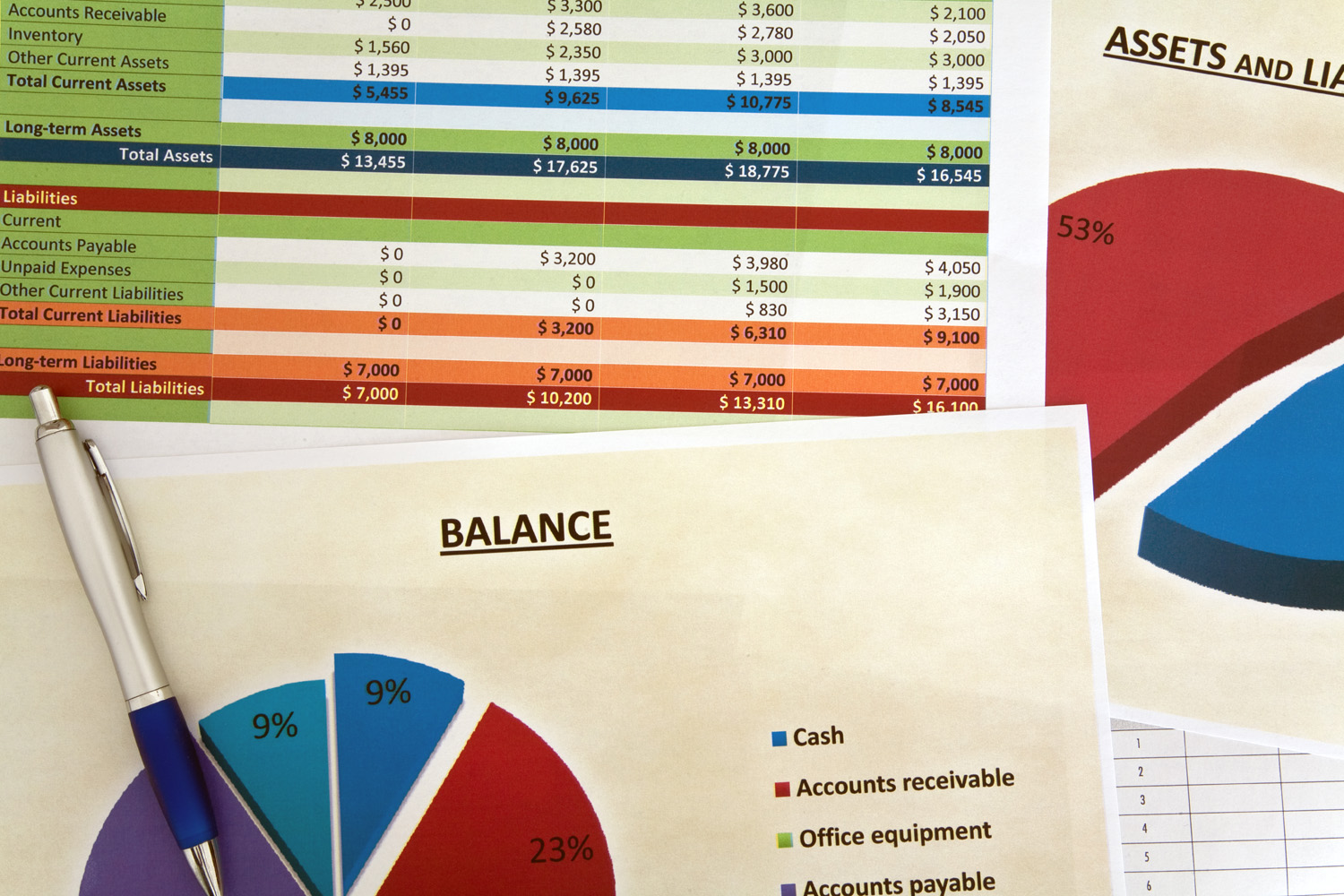 A balance sheet is a record of stocks of assets and liabilities of individuals or organisations. Behind these stocks are accounts capturing flows, including income, expenditure, saving and borrowing. There are three types of flow accounts: income, financial and capital. Together, the balance sheets and flow accounts provide important insights into the overall financial position of individuals or organisations as well as the factors contributing to changes in their financial well-being.
A balance sheet is a record of stocks of assets and liabilities of individuals or organisations. Behind these stocks are accounts capturing flows, including income, expenditure, saving and borrowing. There are three types of flow accounts: income, financial and capital. Together, the balance sheets and flow accounts provide important insights into the overall financial position of individuals or organisations as well as the factors contributing to changes in their financial well-being.
The stock value of a sector’s or country’s non-financial assets and its net financial worth (i.e. the balance of financial assets over liabilities) is referred to as its net worth. Non-financial assets include produced assets, such as dwellings and other buildings, machinery and computer software, and non-produced assets, largely land.
An increase in the net worth of the sectors or the whole country implies greater financial well-being, while a decrease implies greater financial stress. Yet a deeper understanding of financial well-being also requires an analysis of the composition of the balance sheets as well as their potential vulnerabilities from shocks, such as interest rate rises, falling asset prices or borrowing constraints.
UK net worth
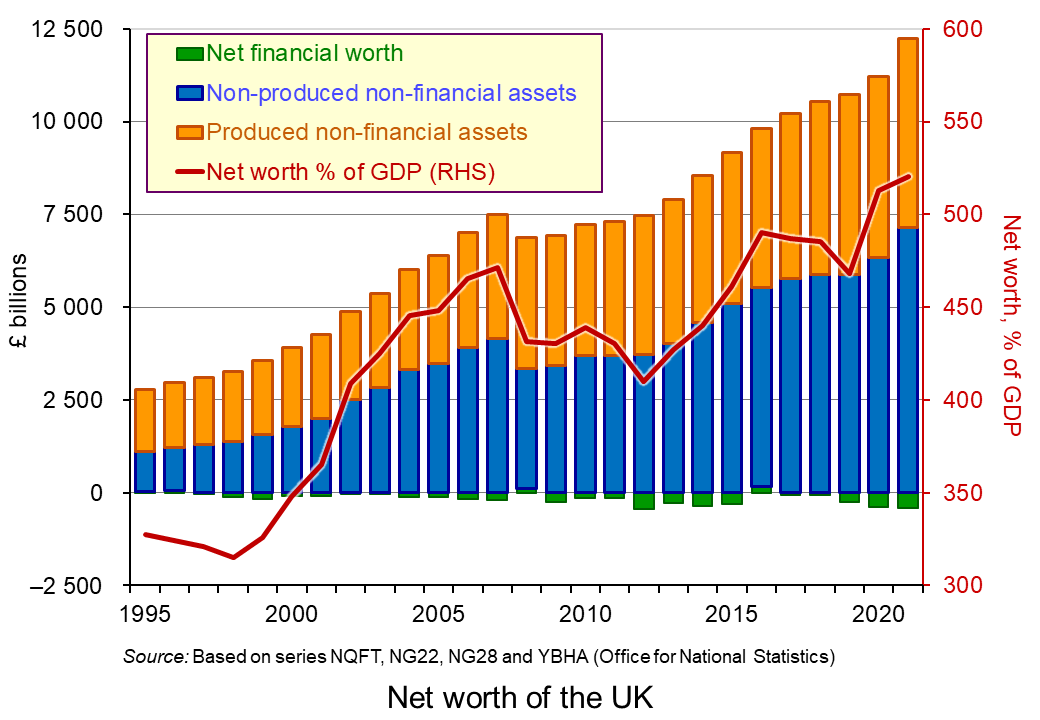 The chart shows the UK’s stock of net worth since 1995, alongside its value relative to annual national income (GDP) (click here for a PowerPoint). In 2021, the net worth of the UK was £11.8 trillion, equivalent to 5.2 times the country’s annual GDP. This marked an increase of £1.0 trillion or 9 per cent over 2020. This was driven largely by an increase in land values (non-produced non-financial assets).
The chart shows the UK’s stock of net worth since 1995, alongside its value relative to annual national income (GDP) (click here for a PowerPoint). In 2021, the net worth of the UK was £11.8 trillion, equivalent to 5.2 times the country’s annual GDP. This marked an increase of £1.0 trillion or 9 per cent over 2020. This was driven largely by an increase in land values (non-produced non-financial assets).
In contrast, the stock of net worth fell in both 2008 and 2009 at the height of the financial crisis and the ensuing economic slowdown, which contributed to the country’s net worth falling by over 8 per cent.
The chart shows that net financial assets continue to make a negative contribution to the country’s net worth. In 2021 financial liabilities exceeded financial assets by the equivalent of 19 per cent of annual national income.
Non-financial corporations and the public sector together had financial liabilities in excess of financial assets of £3.4 trillion and £2.5 trillion respectively. However, once non-financial assets are accounted for, non-financial corporations had a positive net worth of £607 billion, although their value was not sufficient to prevent the public sector having a negative net worth of £1.2 trillion. Meanwhile, households had a positive net worth of £11.4 trillion and financial corporations a negative net worth of £4.9 billion.
Vulnerabilities and the balance sheets
The collapse of Silicon Valley Bank (SVB) resulted from balance sheet distress. Some argue that this distress can be attributed to a mismanagement of the bank’s liquidity position, which saw the bank use the surge in funds, on the back of buoyant activity among technology companies, to purchase long-dated bonds while, at the same time, reducing the share of assets held in cash. However, as the growth of the technology sector slowed as pandemic restrictions eased and, crucially, as central banks, including the Federal Reserve, began raising rates, the value of these long-dated bonds fell. This is because there is a negative relationship between interest rates and bond prices. Bonds pay a fixed rate of interest and so as other interest rates rise, bonds become less attractive to savers, pushing down their price. As depositors withdrew funds, Silicon Valley Bank found itself increasingly trying to generate liquidity from assets whose value was falling.
A major problem with balance sheet distress is contagion. This can occur, in part, because of what is known as ‘counterparty risk’. This simply refers to the idea that one party’s well-being is tied directly to that of another. However, the effects on economies from counterparty risks can be amplified by their impact on general credit conditions, confidence and uncertainty. This helps to explain why the US government stepped in quickly to guarantee SVB deposits.
There is, however, a ‘moral hazard’ problem here: if central banks are always prepared to step in, it can signal to banks that they are too big to fail and disincentivise them for adopting appropriate risk management strategies in the first place.
Subsequently, First Citizens Bank acquired the commercial banking business of SVB, while its UK subsidiary was acquired by HSBC for £1.
Interest rates and financial well-being
In light of the failures of SVB and Credit Suisse, the raising of interest rates by inflation-targeting central banks has raised concerns about the liquidity and liabilities positions of banks and non-bank financial institutions, such as hedge funds, insurers and pension funds. As we have seen, higher interest rates push down the value of bonds, which form a major part of banks’ balance sheets. The problem for central banks is that, if this forced them to make large-scale injections of liquidity by buying bonds (quantitative easing), it would make the fight against inflation more difficult. Quantitative easing is the opposite of tightening monetary policy and thus credit conditions, which are seen as necessary to control inflation.
 Yet the raising of interest rates has implications for the financial well-being of other sectors too since they also are affected by the effects on asset values and debt-servicing costs. For example, raising interest rates has a severe impact on the cashflow of UK homeowners with large variable-rate mortgages. This can substantially affect their spending. The UK has a high proportion of homeowners on variable-rate mortgages or fairly short-term fixed-rate mortgages. Also for a large number of households their mortgages are high relative to their incomes.
Yet the raising of interest rates has implications for the financial well-being of other sectors too since they also are affected by the effects on asset values and debt-servicing costs. For example, raising interest rates has a severe impact on the cashflow of UK homeowners with large variable-rate mortgages. This can substantially affect their spending. The UK has a high proportion of homeowners on variable-rate mortgages or fairly short-term fixed-rate mortgages. Also for a large number of households their mortgages are high relative to their incomes.
In short, falling asset values and increasing debt-servicing costs from rising interest rates in response to rising inflation tends to dampen spending in the economy. The effects will be larger the more burdened with debt people and businesses are, and the less liquidity they have to access. This has the potential to lead to a financial consolidation in order to restore the well-being of balance sheets. This involves cutting borrowing and spending.
Such a consolidation could be exacerbated if financial institutions become distressed and if it were to result in even larger numbers of people and businesses facing greater restrictions in accessing credit. These balance sheet pressures will continue to weigh on the policy responses of central banks as they attempt to navigate economies out of the current inflationary pressures.
Articles
Questions
- What is recorded on a balance sheet? Explain with reference to the household sector.
- What is meant by net worth? Does an increase in net worth mean that an individual’s or sector’s financial well-being has increased?
- What is meant by ‘liquidity-constrained’ individuals or businesses? What factors might explain how liquidity constraints arise?
- It is sometimes argued that there is a predator-prey relationship between income and debt. How could such a relationship arise and what is its importance for the economy?
- Why might a deterioration of a country’s balance sheets have both national and international consequences?
- Explain the possible trade-offs facing central banks when responding to inflationary pressures.
Why did a competition authority change its mind on one aspect of this merger?
In January 2022, Microsoft announced its plan to acquire Activision Blizzard for $68.7 billion. Activision Blizzard is one of the largest games publishers in the world and famous for titles such as Call of Duty and World of Warcraft. Sales revenue from Call of Duty: Modern Warfare II was over $10 billion within ten days of its release in 2022. Given Microsoft’s ownership of the Xbox, one of the three devices that dominate the market for gaming consoles, the deal was always likely to raise competition concerns.
Potential competition issues
 Following Phase 1 and 2 merger investigations by the Competition and Markets Authority (CMA) a number of competition issues were raised. One particular concern was in the market for gaming consoles and the potential impact of the merger on the future availability of Call of Duty (CoD). Some of the key findings of the initial research undertaken by the CMA were that:
Following Phase 1 and 2 merger investigations by the Competition and Markets Authority (CMA) a number of competition issues were raised. One particular concern was in the market for gaming consoles and the potential impact of the merger on the future availability of Call of Duty (CoD). Some of the key findings of the initial research undertaken by the CMA were that:
- Sony’s PlayStation was a much closer rival for the Xbox than the Nintendo Switch, which tends to offer more family-orientated games.
- PlayStation users spend significant amounts of gametime playing CoD.
- Game availability is a key factor that influences console purchase decisions.
- Twenty-four percent of PlayStation users who play CoD stated that they would not purchase future versions of the console if CoD was unavailable on the platform.
These findings suggest that there are commercial incentives for Microsoft to limit the availability of CoD on the PlayStation. For example, the newly merged business could make future versions of the game exclusive to the Xbox – total exclusivity. Alternatively, it could adopt a policy of partial exclusivity. For example, it could only make versions of CoD available on the PlayStation that exclude some of its more popular features.
 There are costs to Microsoft of implementing a policy of total or partial exclusivity. For example, 76% per cent of PlayStation users who play CoD stated that they would not switch consoles if future versions of the game were made unavailable. By making CoD exclusive to Xbox users, Microsoft would lose revenue from forgoing potential sales of the game to this group of users. The firm may also suffer reputational damage if there was a social media backlash against an exclusivity decision.
There are costs to Microsoft of implementing a policy of total or partial exclusivity. For example, 76% per cent of PlayStation users who play CoD stated that they would not switch consoles if future versions of the game were made unavailable. By making CoD exclusive to Xbox users, Microsoft would lose revenue from forgoing potential sales of the game to this group of users. The firm may also suffer reputational damage if there was a social media backlash against an exclusivity decision.
However, these costs of implementing a policy of exclusivity could be outweighed by the potential benefits. These include:
- The additional sales of consoles as some users switch from the PlayStation to the Xbox to gain access to CoD.
- the sale of CoD and other games to these additional Xbox users.
To quantify these costs and benefits, the CMA used a financial model that includes information on the amounts of money users typically spend on the Xbox platform and CoD over a five-year period. This ‘lifetime value of customers’ model found that it would be profitable for Microsoft to implement a policy of exclusivity post-merger.
The CMA also noted that in the majority of cases where Microsoft had previously acquired gaming studios, the subsequent release of games had been made exclusive to the Xbox.
CMA findings
 Following its analysis of the case, the CMA published its provisional findings on the 8th February 2023. One key finding was that the merger would harm consumers, as it would lead to a substantial lessening of competition in the supply of console gaming services. The CMA argued that the acquisition should proceed only if Activision Blizzard sold off the parts of its business responsible for producing CoD. This is a structural remedy.
Following its analysis of the case, the CMA published its provisional findings on the 8th February 2023. One key finding was that the merger would harm consumers, as it would lead to a substantial lessening of competition in the supply of console gaming services. The CMA argued that the acquisition should proceed only if Activision Blizzard sold off the parts of its business responsible for producing CoD. This is a structural remedy.
Microsoft rejected these findings and argued that the financial modelling used by the CMA was based on inaccurate data. In its formal written response to the competition authority the company argued that:
- The potential gains from a policy of exclusivity had been calculated over a five-year period whereas the costs (i.e. the forgone sales of CoD) had only been calculated over a one-year period. More accurate analysis should compare both the potential gains and losses over a five-year period.
- When more recent data are used to calculate the amounts of money users typically spend on the Xbox platform and CoD over a five-year period, the figure is lower than in the original work by the CMA.
Revised CMA findings
Having adjusted its analysis to take account of these criticisms, the CMA published an update to its Provisional Findings on 24th March 2023. In this update the competition authority stated that:
The analysis now shows that it would not be commercially beneficial to Microsoft to make CoD exclusive to Xbox following the deal, but that Microsoft will instead still have the incentive to continue to make the game available on PlayStation.
Therefore, just six weeks after publishing its Provisional Findings the CMA changed its conclusion and stated that the merger would not result in a substantial lessening of competition in the market for the supply of console gaming services in the UK.
In response to these changes an ex-CMA lawyer stated that:
This is extremely unusual. Restating your provisional findings is something ‘you would rather die than do’.
It is important to remember that the investigation by the CMA also raised concerns about the impact of the acquisition on competition in the cloud gaming market. These concerns remain unaffected by these updated findings and a final report will be published by the CMA at the end of April.
Competition authorities from 16 different countries/regions are also investigating the deal, including the Federal Trade Commission in the USA and the European Commission. It will be interesting to see if these authorities agree on the potential impact of the merger on competition.
Articles
CMA documentation
Questions
- Under what circumstances could a merger result in a substantial lessening of competition?
- Summarise the thresholds that have to be met by a potential merger before it is investigated by the Competition and Markets Authority.
- Explain the direct and indirect network effects that exist in the console gaming market. To what extent do they create barriers to entry?
- Outline some different ways that Microsoft could introduce a policy of partial exclusivity for the Call of Duty franchise of games.
- What would be the impact of a policy of exclusivity on the cross price elasticity of demand between Xbox and PlayStation consoles?
- Outline the difference between behavioural and structural remedies for merger.
- Discuss why the acquisition of Activision by Microsoft might reduce competition in the cloud gaming market.
 This is the second of three blogs looking at high inflation and its implications. Here we look at changes in the housing market and its effects on households. Another way of analysing the financial importance of the housing and mortgage markets is through the balance sheets and associated flow accounts of the household sector.
This is the second of three blogs looking at high inflation and its implications. Here we look at changes in the housing market and its effects on households. Another way of analysing the financial importance of the housing and mortgage markets is through the balance sheets and associated flow accounts of the household sector. 
 Housing is also an important asset on household balance sheets. The price of housing reflects both the value of dwellings and the land on which they sit, and these are recorded separately on the balance sheets. Their combined balance sheet value increased from £1.09 trillion (£467.69bn + £621.49bn) in 1995 to £6.38 trillion (£1529.87bn + £4853.16bn) in 2021 or from 128% of GDP to 281%.
Housing is also an important asset on household balance sheets. The price of housing reflects both the value of dwellings and the land on which they sit, and these are recorded separately on the balance sheets. Their combined balance sheet value increased from £1.09 trillion (£467.69bn + £621.49bn) in 1995 to £6.38 trillion (£1529.87bn + £4853.16bn) in 2021 or from 128% of GDP to 281%. The advent of higher interest rates was expected not only to impact on the debt servicing costs of households but the value of assets, including, in the context of this blog, housing. As Chart 3 in the previous blog helped to show, higher interest rates and higher mortgage repayments contributed to an easing of house price growth as housing demand eased. On the other hand, the impact on mortgaged landlords helped fuel the growth of rental prices as they passed on their increased mortgage repayment costs to tenants.
The advent of higher interest rates was expected not only to impact on the debt servicing costs of households but the value of assets, including, in the context of this blog, housing. As Chart 3 in the previous blog helped to show, higher interest rates and higher mortgage repayments contributed to an easing of house price growth as housing demand eased. On the other hand, the impact on mortgaged landlords helped fuel the growth of rental prices as they passed on their increased mortgage repayment costs to tenants. This is the first of three blogs looking at inflation, at its effect on household budgets and at monetary policy to bring inflation back to the target rate. This first one takes an overview.
This is the first of three blogs looking at inflation, at its effect on household budgets and at monetary policy to bring inflation back to the target rate. This first one takes an overview.  Despite easing somewhat, the CPI inflation rate is showing signs of persistence – meaning that it is taking time for it to return to target. One way of understanding this persistence is to look at a measure of inflation known as core inflation. This inflation rate measure excludes energy, food, alcoholic beverages and tobacco prices, all of which are notoriously volatile. Core inflation thus captures underlying inflationary pressures.
Despite easing somewhat, the CPI inflation rate is showing signs of persistence – meaning that it is taking time for it to return to target. One way of understanding this persistence is to look at a measure of inflation known as core inflation. This inflation rate measure excludes energy, food, alcoholic beverages and tobacco prices, all of which are notoriously volatile. Core inflation thus captures underlying inflationary pressures. The increase in the Bank Rate is reflected in the increases in mortgage rates shown in Chart 2 (click
The increase in the Bank Rate is reflected in the increases in mortgage rates shown in Chart 2 (click  Chart 3 provides a visual picture of the typical annual repayment costs facing first-time buyers as a percentage of earnings after tax and national insurance (click
Chart 3 provides a visual picture of the typical annual repayment costs facing first-time buyers as a percentage of earnings after tax and national insurance (click  Many people in the games industry expected the Competition and Markets Authority (CMA) to approve Microsoft’s proposed takeover of the games business, Activision Blizzard. However, in its
Many people in the games industry expected the Competition and Markets Authority (CMA) to approve Microsoft’s proposed takeover of the games business, Activision Blizzard. However, in its  In response to the first issue, the CMA judged that restricting access to Activision Blizzard’s games post-merger would significantly harm the competitiveness of Microsoft’s rivals in both the console and cloud gaming markets. However, its judgment on the second issue differed between the two markets. Why was this? One key issue was the difference in the relative market power of Microsoft in cloud vs console gaming.
In response to the first issue, the CMA judged that restricting access to Activision Blizzard’s games post-merger would significantly harm the competitiveness of Microsoft’s rivals in both the console and cloud gaming markets. However, its judgment on the second issue differed between the two markets. Why was this? One key issue was the difference in the relative market power of Microsoft in cloud vs console gaming. Cloud gaming offers consumers a new way of playing graphically complex games. In this sector of the market, the games run on remote servers/data centres and then stream over the internet to the user’s device. The great advantage with this approach is that it enables consumers to play games on less powerful hardware devices such as smartphones, tablets, smart televisions, and standard PCs. Although the market is currently quite small it, has grown significantly over the past couple of years. Some people argue that it has the potential to make a dramatic change to the gaming market in the same way that businesses such as Netflix and Spotify have transformed the film, TV, and music industries.
Cloud gaming offers consumers a new way of playing graphically complex games. In this sector of the market, the games run on remote servers/data centres and then stream over the internet to the user’s device. The great advantage with this approach is that it enables consumers to play games on less powerful hardware devices such as smartphones, tablets, smart televisions, and standard PCs. Although the market is currently quite small it, has grown significantly over the past couple of years. Some people argue that it has the potential to make a dramatic change to the gaming market in the same way that businesses such as Netflix and Spotify have transformed the film, TV, and music industries. March 2023 saw the failure of Silicon Valley Bank (SVB), a regional US bank based in California that focused on financial services for the technology sector. It also saw the forced purchase of global-banking giant, Credit Suisse, by rival Swiss bank, UBS. These events fuelled concerns over the banking sector’s financial well-being, with fears for other financial institutions and the wider economy.
March 2023 saw the failure of Silicon Valley Bank (SVB), a regional US bank based in California that focused on financial services for the technology sector. It also saw the forced purchase of global-banking giant, Credit Suisse, by rival Swiss bank, UBS. These events fuelled concerns over the banking sector’s financial well-being, with fears for other financial institutions and the wider economy. A balance sheet is a record of stocks of assets and liabilities of individuals or organisations. Behind these stocks are accounts capturing flows, including income, expenditure, saving and borrowing. There are three types of flow accounts: income, financial and capital. Together, the balance sheets and flow accounts provide important insights into the overall financial position of individuals or organisations as well as the factors contributing to changes in their financial well-being.
A balance sheet is a record of stocks of assets and liabilities of individuals or organisations. Behind these stocks are accounts capturing flows, including income, expenditure, saving and borrowing. There are three types of flow accounts: income, financial and capital. Together, the balance sheets and flow accounts provide important insights into the overall financial position of individuals or organisations as well as the factors contributing to changes in their financial well-being. The chart shows the UK’s stock of net worth since 1995, alongside its value relative to annual national income (GDP) (click
The chart shows the UK’s stock of net worth since 1995, alongside its value relative to annual national income (GDP) (click